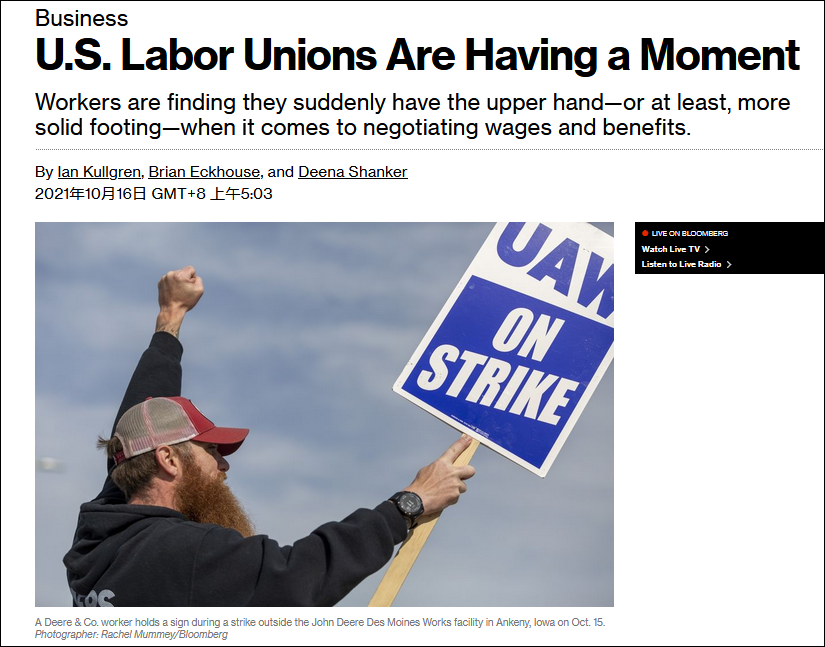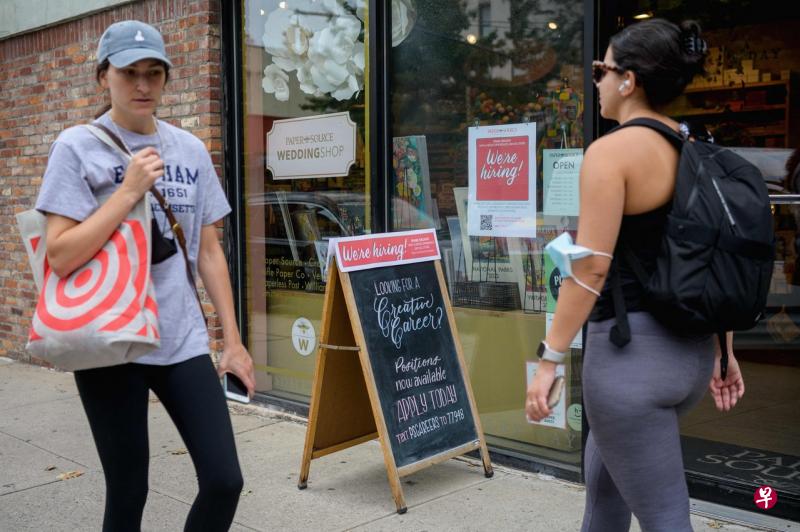美国10万人加入罢工潮 美媒:工人们再也无法忍受了
文章来源: 凤凰网
10/19/2021
“美国工人正处于一种战斗状态。”
“美国工人们受够了,他们正在展示自己的力量。”
“这是美国工人们的反抗。”
近段时间,美国工人频频成为各大美媒报道的主角。新冠疫情暴发近两年后,伴随着美国供应链危机和高居不下的通胀率,一场罢工浪潮正在全美机械、食品、医疗、娱乐等行业加速蔓延,加剧着美国劳动力短缺的危机。
彭博社数据显示,美国已有约10万名工会工人正在罢工或准备罢工;仅在最近两个月,全美就已有近40家工厂爆发了罢工事件,几乎是去年同期的两倍。另据美国劳工部10月最新数据,全美8月有430万人辞职,数据创下20年来新高;辞职率高达2.9%,更刷新了有统计以来的最高值。
在美国媒体看来,这场正在发酵的罢工由诸多因素共同推动。工人们意识到,他们在疫情期间工作付出了巨大的牺牲,相比于公司挣得的利润,他们有权要求更好的福利待遇;而紧俏的劳动力市场进一步增加了谈判的筹码。此外,媒体的关注和部分政治力量的支持,也为他们争取权益创造了良好的外部环境。
“罢工是人们内心不安的表现之一,突显出一种普遍的挫败感。”美国罗格斯大学教授托德·瓦尚(Todd Vachon)说,“尽管我无法预测一场持久变革的发生,但现在看来这将成为现实。”
“我们的忍耐已经到达了极限”
据彭博社报道,10月以来,从美国机械、食品生产线上的工人,到马萨诸塞州的护士和肯塔基州的酿酒师,再到好莱坞的工作人员,全美各行各业超过10万名工人要么正在罢工、要么正准备罢工。
本周四(14日),在拒绝了公司提高工资和福利待遇的临时协议后,美国机械设备生产商约翰迪尔公司(John Deere)约1万名工人已经开始罢工。就在数天之前,美国知名食品企业家乐氏 (Kellogg’s)也爆发了规模为1400人的罢工事件,这些工人对每周7天工作制和退休制度感到不满。
除了已经暴发的罢工外,全美其他工会也在筹备类似的行动:由于受法律限制,飞行员无法实施罢工,美国航空公司(AAL)的飞行员选择22日在迈阿密机场举行抗议,表达对工作条件和航班调度的不满。
“我们的忍耐已经达到了极限。”一位美国航空公司员工说道。

此外,拥有6万名成员的好莱坞工会正准备在下周一(18日)举行罢工,以抗议员工就餐时间不足和周末休息等基本生活质量问题。这次罢工一旦实施,可能会导致多部电影、电视剧和流媒体剧作制作中断,将成为好莱坞工会128年历史上的首起罢工事件。
据彭博社统计数据,自8月1日以来,全美有近40家工厂举行了罢工,这一数字几乎是去年同期的两倍。

“参加罢工反映出广大工人阶级不安的情绪。”《纽约时报》注意到,全球知名调查机构盖洛普(Gallup)7月的统计显示,美国有48%的工人“正在考虑跳槽”。美国劳工部12日发布的最新数据显示,今年8月全美辞职人数达到了430万人,辞职率为2.9%,双双达到历史新高。其中,餐厅、酒店和医疗保健行业成为工人们辞职或转岗的高发地,因为这些在行业工作的人面临着更高的感染风险。
美国工人反思:为何我要呆在这个糟糕的岗位上?
美国有线电视新闻网(CNN)报道指出,在美国疫情暴发19个月后,劳动力市场正以一种数十年来从未见过的方式发生改变。在这种改变中,雇员而非雇主占据了主导地位,这让工会得以施展自己的影响。彭博社同样提到,在新冠疫情大流行之后,美国工会工人们突然发现,他们突然在工资和福利谈判中占据了上风。
美媒注意到,在一系列罢工事件中,绝大多数的,和潜在的罢工者都是第一次这么做。包括疫情、通胀、供应链危机在内的一系列相关事件,激起了他们与公司谈判的勇气,“他们决定拿回那些本属于自己的东西”。

在罢工背后的诸多因素中,首先便是美国低收入群体面临的工作和生活压力。据《华尔街日报》此前报道,美国9月生活成本再度上升,令通胀率维持在30年高位,甚至可能会“波及”到明年。9月的消费者价格指数(CPI)增长了0.4%,食品、住房和汽油的价格上涨推动了大部分的CPI涨幅。
CNN在报道中一针见血地指出,虽然美国是一个富裕国家,但这个国家工人的收入待遇却非常糟糕。在2019年,典型男性工人的收入相较于40年前几乎没有增长。在持续增长的通胀面前,许多低收入工人的家庭生活受到了严重破坏。
除了经济层面的因素,美国工人们获得的假期也相比于其他发达国家少得多;还有很多美国工人感到自己并没有受到雇主和客户的尊重。在最近一项针对餐厅员工的调查中,高达62%的受访者表示自己受到了顾客的“蔑视”。
“疫情让许多美国工人重新思考他们的生活,他们正在反思自己为何还要呆在这样糟糕的工作岗位上。”《纽约时报》写道。而美国全国广播公司(NBC)同样认为,疫情让工人有时间重新考虑他们的工作重点,这场疫情提醒工人们:他们冒着生命危险工作但无法获得相应的回报。
美国《纽约时报》:美国工人的反抗
“新冠疫情给我们敲响了警钟,因为你不仅会在工作中受伤,还可能为此丧命。”美国劳工关系协会劳工教育研究主任凯特·布朗芬布伦纳(Kate Bronfenbrenner)说,“工人们感觉自己比以往任何时候都更努力地工作,但这又是为了什么?”
加州大学伯克利分校法学教授凯瑟琳·菲斯克(Catherine Fisk)给出了相同的观点。“他们面临着高死亡率,但却负担不起住房和医疗保健费用,以至于出现了现在这种绝望而激进的情绪。”
“在疫情中,许多坚持工作的工人受到了公众支持,他们被认为是社会“不可或缺的劳动者”,然而公司却没采取必要措施奖励他们的牺牲。”美国劳工联合会-主席利兹·舒勒(Liz Shuler)13日在华盛顿的一次演讲中说,“员工厌倦了前一天受到感谢,第二天却被当作可有可无的人。”
美媒认为,对与那些生活面临的巨大压力、付出没有得到相应回报的美国工人来说,公司利润的增长同样对他们的心理造成不小的刺激,因为公司并未与他们分享收益。
彭博社援引的一份文件透露,由于疫情封锁,人们更多选择在家中烹饪,主营麦片的美国食品企业家乐氏(Kellogg’s)从中获益颇丰。2021年该公司利润达到了创纪录的41亿美元,公司CEO史蒂文·卡希尔兰(Steven Cahillane)去年获得了价值1167万美元的薪酬。
“疫情期间,工人们拼命生产满足麦片增长的需求。但现在他们还在忍受着长时间的工作,却没有享受到公司利润增长带来的好处。”罗格斯大学劳动关系教授贝卡·吉万(Rebecca Givan)说。
值得注意的是,受工人辞职率攀升的影响,美国劳动力市场面临着严重的工人短缺。美劳工部报告显示,全美劳动力短缺的情况比之前预测的还要严重,今年7月美国空缺职位数达到1110万,是自2000年有记录以来的最高水平;尽管8月这一数字下降到1040万,但供需市场仍处于严重失衡状态。
也正是劳动力市场处于“用工荒”,美国工人们不必担心自己会被轻易取代,这增加了他们谈判的筹码。
“坦白讲,在这个劳动力短缺的时期,为了留住工人,作为一个雇主你不得不提供更好的培训和福利。”美国独立研究机构Beacon Economics LLC的创始合伙人克里斯·索恩伯格(Chris Thornberg)表示,“工人们能感觉到,他们处在主导地位。”
美国的PNC金融服务集团首席经济学家格斯·福彻(Gus Faucher)说,对工人而言,“如果你对自己的工作不满意,或者想要加薪,在目前的环境下,很容易找到一份新工作。我们看到人们正在用脚投票。”
“劳动力市场或发生持久性的变革”
目前,这场蔓延全美多个行业的罢工潮仍未出现缓解的迹象。
全球领先的审计、税务和咨询事务所网络RSM首席经济学家乔·布鲁修拉斯(Joe Brusuelas)认为,从短期来看,工人短缺将继续导致全球经济的重新开放复杂化,生产成本和商品价格上涨,加剧供应链压力、产品短缺和航运延误等问题。而长期而言,美国工人们将会有更强的信心去争取自己应得的利益。
“这种转变不仅仅是经济学角度上,更是美国工人对生活质量和目标的更广泛的重新评估。”布鲁修拉斯说,在上世纪的大萧条后美国已经很久没有发生过这样的事情,“这种令人意想不到的变化,依然需要时间来消化。”
“罢工是人们内心不安的表现之一,突显出一种普遍的挫败感。”美国罗格斯大学教授托德·瓦尚(Todd Vachon)说,“尽管我无法预测一场持久变革的发生,但现在看来这将成为现实。”
CNN评论道,如今时机成熟了,工人们明确无误地展现出了自己的态度,正如一名罢工工人所描述的那样,罢工不再是孤立的感觉,“劳动者终于做好了战斗的准备。”
近20%美国家庭在疫情期间失去全部积蓄
文 / 林煇智
10/14/2021

(早报讯)美国一项调查发现,近20%的美国家庭在冠病疫情期间失去全部积蓄。
彭博社报道,美国国家公共广播电台、罗伯特·伍德·约翰逊基金会和哈佛大学T.H.陈公共卫生学院对3616名18岁以上的美国成年人进行调查。调查发现,年收入低于5万美元(6.74万新元)的人,花光储蓄的比例跃升至30%。
罗伯特·伍德·约翰逊基金会副总裁约瑟夫说,许多人动用储蓄来支付儿童或医疗保健费用。他说:“当危机来临时,或者任何事情变得不正常时,例如,你的孩子生病了,你正在花掉工资。”
在年收入低于5万美元的家庭中,几乎三分之二的家庭表示难以负担房租、医疗和食物。大约三分之二的受访者表示,在过去几个月中获得了政府的援助。但44%的人表示这些“只起到了一点作用”。
约瑟夫说:“我们一直都觉得复苏会不平衡。”“安全网总是有漏洞,而大流行将这些漏洞撕得更大。”

Tel: 551-580-4856 | Email: F.WINNIE.S@GMAIL.COM
诚招美国和加拿大法律服务代理
因公司发展需要,诚招美国和加拿大法律服务代理。
要求:
懂英语、或西班牙语、或法语。
能合法工作有社安号或工号。
无需改行, 可以兼职。
大学生和有销售经验优先考虑。
自雇生意公司发美国报税1099,加拿大T4A
有意了解详情, 请扫码加微信, 非诚勿扰!

Six Spaces Home Staging

Contact: Hongliang Zhang
Tel: 571-474-8885
Email: zhl19740122@gmail.com
报告:发达国家疫情期间损失的就业岗位仅恢复一半
文 / 林煇智
7/07/2021

(早报讯)经济合作与发展组织(OECD)在一份报告中指出,发达国家在疫情期间损失的就业岗位仅恢复了一半,其中年轻人和低技能劳动者受到的冲击最大。
彭博社报道,经合组织表示,截至2020年底,工业国家有大约2200万个工作岗位消失,而这些国家必须到明年年底才能完全恢复到疫情之前的就业水平。
研究表明,冠病危机加速了过去十年开始的一系列趋势,包括收入不平等加剧、向技术要求更高工作的转变、以及低技能工作者的稳定就业机会减少。
经合组织的就业、劳工和社会事务主管斯卡佩特说:“现在不解决不平等和排斥问题不仅可能导致更深层次的社会分裂,而且会对生产力和经济复苏产生负面影响。”
经合组织发现长期失业“快速累积”,每一波疫情限制措施都使人们重返劳动力市场道路的难度增加。该组织表示,疫情期间全球约有1.14亿个工作岗位流失。

Tel: 551-580-4856 | Email: F.WINNIE.S@GMAIL.COM
Four-day week ‘an overwhelming success’ in Iceland
BBC
7/06/2021

Reykjavík City Council took part in the trial
Trials of a four-day week in Iceland were an “overwhelming success” and led to many workers moving to shorter hours, researchers have said.
The trials, in which workers were paid the same amount for shorter hours, took place between 2015 and 2019.
Productivity remained the same or improved in the majority of workplaces, researchers said.
A number of other trials are now being run across the world, including in Spain and by Unilever in New Zealand.
In Iceland, the trials run by Reykjavík City Council and the national government eventually included more than 2,500 workers, which amounts to about 1% of Iceland’s working population.
A range of workplaces took part, including preschools, offices, social service providers, and hospitals.
Many of them moved from a 40 hour week to a 35 or 36 hour week, researchers from UK think tank Autonomy and the Association for Sustainable Democracy (Alda) in Iceland said.
The trials led unions to renegotiate working patterns, and now 86% of Iceland’s workforce have either moved to shorter hours for the same pay, or will gain the right to, the researchers said.
Workers reported feeling less stressed and at risk of burnout, and said their health and work-life balance had improved. They also reported having more time to spend with their families, do hobbies and complete household chores.
Will Stronge, director of research at Autonomy, said: “This study shows that the world’s largest ever trial of a shorter working week in the public sector was by all measures an overwhelming success.
“It shows that the public sector is ripe for being a pioneer of shorter working weeks – and lessons can be learned for other governments.”
Gudmundur Haraldsson, a researcher at Alda, said: “The Icelandic shorter working week journey tells us that not only is it possible to work less in modern times, but that progressive change is possible too.”
Spain is piloting a four day working week for companies in part due to the challenges of coronavirus.
And consumer goods giant Unilever is giving staff in New Zealand a chance to cut their hours by 20% without hurting their pay in a trial.
In May, a report commissioned by the 4 Day Week campaign from Platform London suggested that shorter hours could cut the UK’s carbon footprint.
Source: https://www.bbc.com/news/business-57724779
Federal Communications Commission
Emergency Broadband Benefit

The Emergency Broadband Benefit is an FCC program to help families and households struggling to afford internet service during the COVID-19 pandemic. This new benefit will connect eligible households to jobs, critical healthcare services, virtual classrooms, and so much more.
About the Emergency Broadband Benefit
The Emergency Broadband Benefit will provide a discount of up to $50 per month towards broadband service for eligible households and up to $75 per month for households on qualifying Tribal lands. Eligible households can also receive a one-time discount of up to $100 to purchase a laptop, desktop computer, or tablet from participating providers if they contribute more than $10 and less than $50 toward the purchase price.
The Emergency Broadband Benefit is limited to one monthly service discount and one device discount per household.
Who Is Eligible for the Emergency Broadband Benefit Program?
A household is eligible if a member of the household meets one of the criteria below:
- Has an income that is at or below 135% of the Federal Poverty Guidelines or participates in certain assistance programs, such as SNAP, Medicaid, or Lifeline;
- Approved to receive benefits under the free and reduced-price school lunch program or the school breakfast program, including through the USDA Community Eligibility Provision in the 2019-2020 or 2020-2021 school year;
- Received a Federal Pell Grant during the current award year;
- Experienced a substantial loss of income due to job loss or furlough since February 29, 2020 and the household had a total income in 2020 at or below $99,000 for single filers and $198,000 for joint filers; or
- Meets the eligibility criteria for a participating provider’s existing low-income or COVID-19 program.
How to Apply
The online application for the Emergency Broadband Benefit Program is experiencing high demand. We appreciate your patience as we actively work to resolve any connectivity issues users may encounter.
Apply Now
There are three ways for eligible households to apply:
- Contact your preferred participating broadband provider directly to learn about their application process.
- Go to GetEmergencyBroadband.org to apply online and to find participating providers near you.
- Call 833-511-0311 for a mail-in application, and return it along with copies of documents showing proof of eligibility to:
Emergency Broadband Support Center
P.O. Box 7081
London, KY 40742
After receiving an eligibility determination, households can contact their preferred service provider to select an Emergency Broadband Benefit eligible service plan.
Get More Consumer Information
Check out the Broadband Benefit Consumer FAQ for more information about the benefit.
Which Broadband Providers Are Participating in the Emergency Broadband Benefit?
Various broadband providers, including those offering landline and wireless broadband, are participating in the Emergency Broadband Benefit. Find broadband service providers offering the Emergency Broadband Benefit in your state or territory.
Broadband providers can find more information about how to participate here.
Source: https://www.fcc.gov/broadbandbenefit
Evictions During COVID-19: Landlords’ Rights and Options When Tenants Can’t Pay Rent
Tips, resources, and advice for landlords whose tenants aren’t able to pay the rent due to the coronavirus outbreak.
By Ann O’Connell, Attorney
11/01/2020
Many renters are facing financial challenges resulting from coronavirus-related business shut-downs, furloughs, layoffs, and stay-at-home orders. The longer this crisis goes on, the more likely it is that many will not be able to pay their rent. When renters default on rent, landlords suffer, and might not be able to meet their own financial obligations, such as making the mortgage payments on the rental property.
Here are some suggestions about how landlords can mitigate the financial impact of tenant defaults during the COVID-19 outbreak.
Terminations and Evictions
Under normal circumstances, when tenants don’t pay rent, landlords have the option of terminating the tenancy (by serving the tenant with either a pay rent or quit notice or an unconditional quit notice, depending on the applicable laws). When tenants don’t pay the rent or move out by the deadline given in the notice, landlords can then file an eviction lawsuit to have the tenants physically removed from the rental.
However, health and safety concerns due to COVID-19 have led many states, cities, counties, and courts to place moratoriums on evictions. The scope of these temporary bans on evictions varies greatly: some have banned any and all action relating to evictions, while others simply postpone hearings on evictions until the court can arrange a hearing via telephone or video.
If you are a landlord in an area with an eviction moratorium, you might still be able to file eviction papers with the court, but your case might not be heard for a while. However, even if there are no bans in place, evicting tenants who can’t pay the rent due to the coronavirus crisis probably shouldn’t be your first recourse. Aside from optics (you don’t want to get a reputation as the ruthless landlord who booted tenants out of their home in the middle of a stay-at-home order), if you remove tenants right now, you’re going to be faced with having to disinfect the rental, advertise the rental, screen new prospective tenants (of which there might be very few), sign a new lease or rental agreement, and get the new tenants moved in—all while taking measures to abide by emergency guidelines and health and safety measures.
Consider the following options instead.
Evaluate Your Personal Financial Situation
Take a moment to evaluate your own finances. As dire as it sounds, it might be time to take stock of what could happen in a worst-case scenario. Most landlords have likely considered the situation where tenants don’t pay rent, as this can happen at any time. But there’s no denying that this is a different situation—what will happen if your tenants can’t pay for a long time, and your options for finding new (paying) tenants are slim?
Your assessment of how this worst-case scenario will affect your ability to pay your mortgage (if any) and your personal bills will inform how you respond when your tenants can’t pay their rent.
- If your financial situation looks grim: If your ability to pay the mortgage on your rental property hinges on month-to-month rental income, you should take actions to prevent your own default This includes options discussed below, such as contacting your lender and proactively seeking arrangements with tenants that allow them to make at least partial payments.
- If you have a few months’ reserves: If your personal reserves or financial position won’t feel too much of a pinch if tenants aren’t able to pay rent for a while, you still might have to make some compromises to retain good tenants. If you have tenants who have previously been reliable and are simply finding it hard to make ends meet currently, do what you can to take some pressure off them—see the discussion below about working out a temporary solution with tenants.
Try to Work Out a Temporary Solution With Tenants
Depending on how desperately you need to receive income from your rental, you have a few options for working with tenants who aren’t able to pay rent because of COVID-19. Consider the following possible arrangements.
- Forgive rent. If your situation allows for it, you could waive rent for a month, with an agreement to revisit the payment arrangement on a certain date. A landlord in Bakersfield recently did this for his tenants.
- Postpone rent. You could offer to postpone rent payments for a month, with an agreement that it will be repaid. Your repayment arrangement could state that the rent owed could be spread out over time, paid all at once, or paid when (if) a stimulus check
- Reduce rent. If you can, consider dropping the rent temporarily to a level that enables you to meet your obligations but forgoes profit for the time being. For example, if you normally collect $1200 a month, but your mortgage is $900 a month, you could temporarily drop rent to $900 to make sure you at least don’t get in trouble with your lender.
Before deciding to make any of these adjustments, try talking to your tenants. Ask them straight out what they think they can make work. If you’re able to accommodate their suggestions, chances are higher that they will do everything they can to hold up their end of the bargain. Be sure to put any agreements in writing, preferably as an addendum to your current lease or rental agreement that includes all details of the arrangement.
Look for Outside Assistance
Even if you think you can float a month or two without rental income, you still might want to consider taking some measures now to protect your position in the event that the coronavirus crisis lasts longer than your cushion can handle. If you’re already feeling the pinch, take these actions immediately.
Attend to Your Mortgage
At this point in the COVID-19 crisis, most private lenders are willing to work with borrowers to ensure that they don’t lose their homes. Call your lender directly and ask what steps it is taking to assist borrowers who can’t meet their mortgage obligations due to the coronavirus pandemic.
- If your loan is owned by Fannie Mae or Freddie Mac, you might be able to delay making payments for a certain period of time without incurring late fees or getting hit with a credit score penalty.
- Look into your options under the Coronavirus Aid, Relief, and Economic Security Act.
- The Federal Housing Administration (FHA) has put in place a foreclosure moratorium for single family homeowners with FHA-insured mortgages.
- Visit your state’s website to find out if the state is offering assistance to homeowners. For example, New York has announced a delay of mortgage payments for 90 days. Many other states are postponing any foreclosure actions indefinitely. Find your state’s website at State and Government on the Net.

Look Into Property Tax Breaks
Some states and counties are extending the deadline for paying property taxes, or cancelling late fees and interest. Check your county’s tax assessor’s website to see if this is an option where your property is located.
Seek a Loan
Consider seeking a loan from family, friends, or private lenders. The U.S. Small Business Administration might be another source of assistance—its disaster loan assistance web page has a wealth of information. You can also contact your regular bank or credit union and inquire about what assistance it can offer.
Research Options for Your Renters
Some areas are beginning to offer rent vouchers or emergency funds to renters in need. For example, the Pennsylvania Apartment Association is collecting donations for funds to give to renters who can’t pay rent. Currently, renters’ needs are getting a lot more attention in the press than landlords’ needs, and there are already a lot more resources being made available for renters. It’s in your best interest to research these options and bring them to your renters’ attention—do what you can to help your tenants pay you.
Landlords are getting squeezed between tenants and lenders
By ANNE D’INNOCENZIO

NEW YORK (AP) — When it comes to sympathetic figures, landlords aren’t exactly at the top of the list. But they, too, have fallen on hard times, demonstrating how the coronavirus outbreak spares almost no one.
Take Shad Elia, who owns 24 single-family apartment units in the Boston area. He says government stimulus benefits allowed his hard-hit tenants to continue to pay the rent. But now that the aid has expired, with Congress unlikely to pass a new package before Election Day, they are falling behind.
Heading into a New England winter, Elia is worried about such expenses as heat and snowplowing in addition to the regular year-round costs, like fixing appliances and leaky faucets.
Elia wonders how much longer his lenders will cut him slack.
“We still have a mortgage. We still have expenses on these properties,” he said. “But there comes a point where we will exhaust whatever reserves we have. At some point, we will fall behind on our payments. They can’t expect landlords to provide subsidized housing.”
The stakes are particularly high for small landlords, whether they own commercial properties, such as storefronts, or residential properties such as apartments. Many are borrowing money from relatives or dipping into their personal savings to meet their mortgage payments.
The big residential and commercial landlords have more options. For instance, the nation’s biggest mall owner, Simon Property Group, is in talks to buy J.C. Penney, a move that would prevent the department store chain from going under and causing Simon to lose one of its biggest tenants. At the same time, Simon is suing the Gap for $107 million in back rent.
Michael Hamilton, a Los Angeles-based real estate partner at the law firm O’Melveny & Myers, said he expects to see more retail and other commercial landlords going to court to collect back rent as they get squeezed between lenders and tenants.
Residential landlords are also fighting back against a Trump administration eviction moratorium that protects certain tenants through the end of 2020. At least 26 lawsuits have been filed by property owners around the country in places such as Tennessee, Georgia and Ohio, many of them claiming the moratorium unfairly strains landlords’ finances and violates their rights.
Apartment dwellers and other residential tenants in the U.S. owe roughly $25 billion in back rent, and that will reach nearly $70 billion by year’s end, according to an estimate in August by Moody’s Analytics.

An estimated 30 million to 40 million people in the U.S. could be at risk of eviction in the next several months, according to an August report by the Aspen Institute, a nonprofit organization.
Jessica Elizabeth Michelle, 37, a single mother with a 7-month-old baby, represents a growing number of renters who are afraid of being homeless once the moratorium on evictions ends.
The San Francisco resident saw her income of $6,000 a month as an event planner evaporate when COVID-19 hit. Supplemental aid from the federal government and the city helped her pay her monthly rent of $2,400 through September. But all that has dried up, except for the unemployment checks that total less than $2,000 a month.
For her October rent, she handed $1,000 to her landlord. She said her landlord has been supportive but has made it clear he has bills to pay, too.
“I never had an issue of paying rent up until now. I cry all night long. It’s terrifying,” Michelle said. “I don’t know what to do. My career was ripped out from under me. It’s gotten to the point of where it’s like, ‘Am I going to be homeless?’ I have no idea.’”
Some landlords are trying to work with their commercial or residential tenants, giving them a break on the rent or more flexible lease terms. But the crisis is costing them.
Analytics firm Trepp, which tracks a type of real estate loan taken out by owners of commercial properties such as offices, apartments, hotels and shopping centers, found that hotels have a nearly 23% rate of delinquency, or 30 days overdue, on their loans, while the retail industry has a 14.9% delinquency rate as of August.
The apartment rental market has so far navigated the crisis well, with a delinquency rate of 3%, according to Trepp. That’s in part because of the eviction moratorium, along with extra unemployment benefits from Washington that have since expired.
“There are bad actors, but the majority of landlords are struggling and are trying to work with a bad situation,” said Andreanecia M. Morris, executive director of HousingNOLA, a public-private partnership that pushes for more affordable housing in the New Orleans area.
Morris, who works with both landlords and tenants, said that government money wasn’t adequate to help tenants pay their rent, particularly in expensive cities. She is calling for comprehensive rental assistance.
She fears that residential landlords will see their properties foreclosed on next year, and the holdings will be bought by big corporations, which are not as invested in the neighborhoods.
Gary Zaremba, who owns and and manages 350 apartment units spread out over 100 buildings in Dayton, Ohio, said he has been working with struggling tenants — many of them hourly workers in restaurants and stores — and directs them to social service agencies for additional help.
But he is nervous about what’s next, especially with winter approaching and the prospect of restaurants shutting down and putting his tenants out of work. He has a small mortgage on the buildings he owns but still has to pay property taxes and fix things like broken windows or leaky plumbing.
“As a landlord, I have to navigate a global pandemic on my own,” Zaremba said, “and it’s confusing.”








